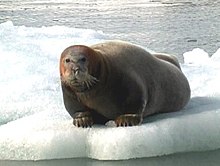Bearded seal
| Bearded Seal[1] | |
|---|---|

| |
| Scientific classification | |
| Kingdom: | |
| Phylum: | |
| Class: | |
| Order: | |
| Family: | |
| Genus: | Erignathus Gill, 1866
|
| Species: | E. barbatus
|
| Binomial name | |
| Erignathus barbatus Erxleben, 1777
| |

| |
| Distribution of bearded seal | |
The bearded seal (Erignathus barbatus), also called the square flipper seal, is a medium-sized pinniped. It is found in and near to the Arctic Ocean.
Fossils indicate that, during the Pleistocene epoch, bearded seals went as far south as South Carolina.[3]
Description
[change | change source]Features of this earless seal include square front flippers and thick bristles on its muzzle. Adults are greyish-brown in colour, darker on the back. Occasionally the face and neck are reddish-brown. Bearded seal pups are born with a greyish-brown fur with scattered patches of white on the back and head. The bearded seal is unique in the subfamily Phocinae in having two pairs of teats. This is a feature it shares with monk seals.
Bearded seals are about 2.1 m (6.9 ft) to 2.7 m (8.9 ft) in nose-to-tail length. They are 200 kg (441 lb) to 430 kg (948 lb) in weight.[4] Both sexes are about the same size.
Bearded seals are a main food source for polar bears and for the Inuit of the Arctic coast. The body fat content of a bearded seal is 30–40%.
Hunting and Diet
[change | change source]Bearded seals feed on a variety of small prey found along the ocean floor, including clams, squid, and fish. Their whiskers serve as feelers[5] in the soft bottom sediments. Adults tend not to dive very deep. They like shallow coastal areas no more than 300 m (980 ft) deep. Pups up to one year old will venture much deeper, diving as deep as 450 m (1,480 ft).
Reproduction and Lifecycle
[change | change source]
Bearded seals give birth in the spring. In the Canadian Arctic, seal pupping is in May. Further south, in Alaska, most pups are born in late April. Pups are born on small drifting ice floes in shallow waters. They usual weigh around 30–40 kg. They enter the water only hours after they are born, and quickly become very good divers. Mothers care for the pups for 18–24 days. During this time the pups grow at an average rate of 3.3 kg per day. Pups consume an average of eight liters of milk a day. By the time they are weaned, the pups have grown to about one hundred kilograms.
Just before the pups are weaned, a new mating cycle takes place. Females ovulate at the end of their lactation period, but stay close to their pups, ready to defend them if necessary. During the mating season, male seals will "sing". This sound may attract females, or may be used by the males to say what territory is theirs or their readiness for breeding. Males live in the same areas from one year to the next.[6]

References
[change | change source]- ↑ Wozencraft, W. C. (2005). "Order Carnivora". In Wilson, D. E.; Reeder, D. M (eds.). Mammal Species of the World (3rd ed.). Johns Hopkins University Press. ISBN 978-0-8018-8221-0. OCLC 62265494.
- ↑ Kovacs, K. & Lowry, L. (2008). "Erignathus barbatus". IUCN Red List of Threatened Species. Version 2008. International Union for Conservation of Nature. Retrieved 28 January 2009.
{{cite web}}: CS1 maint: multiple names: authors list (link) - ↑ Berta, A. & Churchill, M. (2012). "Pinniped Taxonomy: evidence for species and subspecies". Mammal Review. 42 (3): 207–234. doi:10.1111/j.1365-2907.2011.00193.x.
{{cite journal}}: CS1 maint: multiple names: authors list (link) - ↑ Erignathus barbatus. The Animal Diversity Web
- ↑ Saundry, Peter. 2010. Bearded seal. Encyclopedia of Earth. Topic editor C. Michael Hogan, Ed.in Chief: Cutler Cleveland, NCSE, Washington DC
- ↑ Nuttal; et al. (2005). Encyclopedia of the Arctic. New York, NY: Routlelege.

